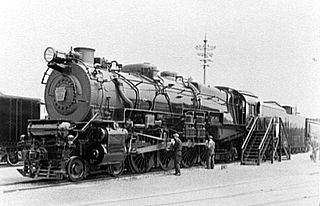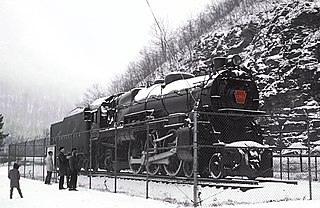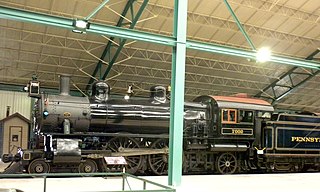
The New York Central Railroad (NYC) called the 4-8-2 type of steam locomotive the Mohawk type. It was known as the Mountain type on other roads, but the New York Central didn't see the name as fitting on its famous Water Level Route. Instead, it picked the name of one of those rivers its rails followed, the Mohawk River, to name its newest type of locomotive. Despite the more common name, the 4-8-2 was actually suited in many ways more to flatland running than slow mountain slogging, with its 4-wheel leading truck for stability at speed. However, the L1s and L2s were unstable at higher speeds due to the design of their reciprocating gear, making the 4-wheel leading truck simply a better distributor of the locomotives weight; the L1s and L2s were consequently limited to 60 mph (97 km/h), but this issue was resolved for the L3s and L4s.
Under the Whyte notation for the classification of steam locomotives, 2-10-0 represents the wheel arrangement of two leading wheels on one axle, ten powered and coupled driving wheels on five axles, and no trailing wheels. This arrangement was often named Decapod, especially in the United States, although this name was sometimes applied to locomotives of 0-10-0 "Ten-Coupled" arrangement, particularly in the United Kingdom. Notable German locomotives of this type include the war locomotives of Class 52.
Locomotive classification on the Pennsylvania Railroad took several forms. Early on, steam locomotives were given single-letter classes. As the 26 letters were quickly assigned, that scheme was abandoned for a more complex system. This was used for all of the PRR's steam locomotives, and — with the exception of the final type bought — all electric locomotives also used this scheme.

The Pennsylvania Railroad (PRR) K4 4-6-2 "Pacific" was its premier passenger-hauling steam locomotive from 1914 through the end of steam on the PRR in 1957.

The M1 was a class of steam locomotive of the Pennsylvania Railroad (PRR). It was a class of heavy mixed-traffic locomotives of the 4-8-2 "Mountain" arrangement, which uses four pairs of driving wheels with a four-wheel guiding truck in front for stability at speed and a two-wheel trailing truck to support the large firebox needed for sustained power. Although built for both passenger and freight work, they spent most of their service lives hauling heavy high-speed freight trains. Many PRR men counted the M1 class locomotives as the best steam locomotives the railroad ever owned.

The Pennsylvania Railroad (PRR) class T1 duplex-drive 4-4-4-4 steam locomotives, introduced in 1942 with two prototypes and later in 1945-1946 with 50 production examples, were the last steam locomotives built for the PRR and arguably its most controversial. They were ambitious, technologically sophisticated, powerful, fast and distinctively streamlined by Raymond Loewy. However, they were also prone to wheelslip both when starting and at speed, in addition to being complicated to maintain and expensive to run. The PRR decided in 1948 to place diesel locomotives on all express passenger trains, leaving unanswered questions as to whether the T1's flaws were solvable, especially taking into account that the two prototypes did not have the problems inherent to the production units.

The Pennsylvania Railroad's S2 class was a steam turbine locomotive designed and built in a collaborative effort by Baldwin Locomotive Works and Westinghouse Electric & Manufacturing Company, as an attempt to prolong the dominance of the steam locomotive by adapting technology that had been widely accepted in the marine industry. One was built, #6200, delivered in September 1944. The S2 was the sole example of the 6-8-6 wheel arrangement in the Whyte notation, with a six-wheel leading truck, eight driving wheels, and a six-wheel trailing truck. The S2 used a direct-drive steam turbine provided by the Westinghouse Electric & Manufacturing Company, geared to the center pair of axles with the outer two axles connected by side rods; the fixed gear ratio was 18.5:1. Such design was to prevent energy loss and S2 achieved a mechanical efficiency of 97% which means only 3% of steam energy was lost within the propulsion equipment. The disadvantage of direct-drive steam turbine was that the turbine could not operate at optimal speeds over the locomotive's entire speed range. The S2 was the largest, heaviest and fastest direct-drive turbine locomotive design ever built.
The Pennsylvania Railroad's class K5 was an experimental 4-6-2 "Pacific" type, built in 1929 to see if a larger Pacific than the standard K4s was worthwhile. Two prototypes were built, #5698 at the PRR's own Altoona Works, and #5699 by the Baldwin Locomotive Works. Although classified identically, the two locomotives differed in many aspects, as detailed below. They were both fitted with a much fatter boiler than the K4s, but dimensionally similar to those of the I1s 2-10-0 "Decapods". Most other dimensions were enlarged over the K4s as well; the exceptions being the 70 square feet (6.5 m2) grate area and the 80 in (2.032 m) drivers.
The Pennsylvania Railroad class Q1, #6130, was a single experimental steam locomotive designed for dual service. The locomotive entered service in 1942, and retired in 1949 after accumulating a relatively low 165,000 service miles.

The USRA Heavy Mikado was a USRA standard class of steam locomotive designed under the control of the United States Railroad Administration (USRA), the nationalized railroad system in the United States during World War I. These locomotives were of 2-8-2 wheel arrangement in the Whyte notation, or 1′D1′ in UIC classification. A total of 233 locomotives were built to this plan for the USRA; postwar, it became a de facto standard design, which was built to the total of 957 locomotives including the USRA originals and all subsequent copies.

The Pennsylvania Railroad's class N2sa comprised rebuilds to PRR practice of the 130 USRA Heavy Santa Fe steam locomotives the railroad received under the auspices of the United States Railroad Administration, the nationalized central control of the nation's railroads during World War I. These locomotives, as received, were classified N2s. Rebuilds began from 1923 and all locomotives were rebuilt, classified N2sa after the rebuild. They received a Belpaire firebox, the PRR-standard smokebox front, a raised headlight following PRR practice, and the bell moved from smokebox front to boiler top. Brakemen's "doghouse" shacks were built on the rear tender decks.

Strasburg Rail Road 475 is a 4-8-0 "Mastodon" type steam locomotive built by the Baldwin Locomotive Works in June 1906 as part of the Norfolk and Western Railway's (N&W) first order of M class numbered 375–499. It was first assigned to haul freight trains on the N&W mainline before being reassigned to branch line duties on the Blacksburg Branch in the 1920s. Retired from revenue service in 1958, No. 475 was sold to various different owners in Pennsylvania, Illinois, and Iowa until 1991 when it was purchased and restored by the Strasburg Rail Road (SRC) in Strasburg, Pennsylvania, where it runs tourist excursion trains in the Pennsylvania Dutch countryside. Since then, No. 475 became the only 4-8-0 locomotive operating in North America and the oldest operating steam locomotive on the SRC.

Class D16 on the Pennsylvania Railroad was their final development of the 4-4-0 "American" type of steam locomotive. A total of 429 of these locomotives were built at the PRR's Juniata Shops, spread across five subclasses; some had 80 in (2,030 mm) diameter driving wheels for service in level territory, while others had 68 in (1,730 mm) drivers for mountainous terrain. In the pre-1895 scheme, these locomotives were second class L.
Class E6 on the Pennsylvania Railroad was the final type of 4-4-2 "Atlantic" locomotive built by the railroad, and second only to the Milwaukee Road's streamlined class A in size, speed and power. Although quickly ceding top-flight trains to the larger K4s Pacifics, the E6 remained a popular locomotive on lesser services and some lasted to the end of steam on the PRR. One, #460, called the Lindbergh Engine, is preserved at the Railroad Museum of Pennsylvania. It was moved indoors to begin preparations for restoration on March 17, 2010. On January 10, 2011, PRR #460 was moved to the museum's restoration shop for a two- to three-year project, estimated to cost $350,000. The engine is listed in the National Register of Historic Places.

The Pennsylvania Railroad's steam locomotive class D1 comprised thirteen 4-4-0 locomotives for express passenger service, constructed at the railroad's own Altoona Works during 1868–1872. They were the first standardized class of locomotives on the railroad and shared many parts with other standard classes.

Pennsylvania Railroad 1361 is a 4-6-2 K4 "Pacific" type steam locomotive built in May 1918 by the Pennsylvania Railroad's (PRR) Juniata Shops in Altoona, Pennsylvania. It hauled mainline passenger and mail trains in Pennsylvania, including commuter trains in New Jersey on the PRR until its retirement from revenue service in 1956. Restored to operating condition for excursion service in 1987, No. 1361 along with its other surviving sister locomotive, No. 3750, were designated as the official state steam locomotives by the Pennsylvania General Assembly. In 1988, it was sidelined due to mechanical problems and was currently owned by the Railroaders Memorial Museum (RMM) in Altoona, Pennsylvania, who were currently attempting to return No. 1361 back to operating condition.
The Pennsylvania Railroad's class L2s was a class of USRA Light Mikados originally purchased (1919) for the subsidiary Grand Rapids and Indiana Railroad. Similar in size to the home-designed and built L1s, the L2s was easily distinguishable by their radial-stay fireboxes and Hodges fabricated trailing trucks. They were built by ALCO. All were retired in 1948

The Pennsylvania Railroad's class E2, E3, E7 steam locomotives were of the 4-4-2 "Atlantic" passenger type, frequently called light Atlantics after the introduction of the heavier E6 Atlantics. All were similar in size and boiler capacity but differed in firebox type, valves and valve gear and cylinder diameter. Classes E2 and E3 were built simultaneously. Starting in 1916 a rebuilding program converted ninety class E2a,b,c to class E7s by replacing slide valves with piston valves and increasing cylinder diameter from 20.5 to 22.5 inches. Fourteen class E2 were similarly converted to class E7sa. Ninety class E2a,d, E3a,d were converted to class E3sd. These improvements allowed many of the engines to remain in active service into the 1930s.

Pennsylvania Railroad 5550 is a mainline duplex drive steam locomotive under construction in the United States. With an estimated completion by 2030, the locomotive will become the 53rd example of the Pennsylvania Railroad's T1 steam locomotive class and the only operational locomotive of its type. The estimated cost of PRR 5550 was originally $10 million, but an updated projected cost of $7 million was released with the acquisition of an existing long-haul tender from the Western New York Railway Historical Society in August 2017. Construction began in 2014 with the casting of the locomotive's keystone-shaped number plate. Major components, including two Boxpok drivers, the prow, the cab, third-course boiler, and fire door have been completed.
The Pennsylvania Railroad's class K29s comprised a single experimental 4-6-2 "Pacific" type steam locomotive. Constructed by Alco-Schenectady, it was given road number 3395. Although only one demonstrator was constructed, the K29s would become the basis for the highly successful K4s Pacifics and L1s Mikados. The lone example spent most of its life on the PRR's Pittsburgh division main line and was retired around 1929.













